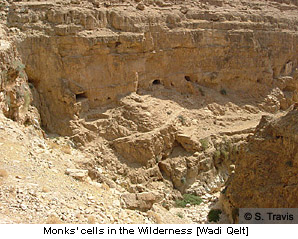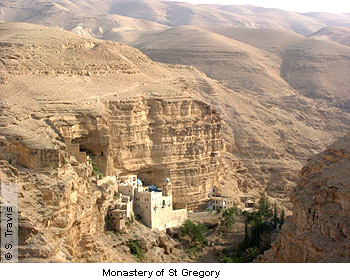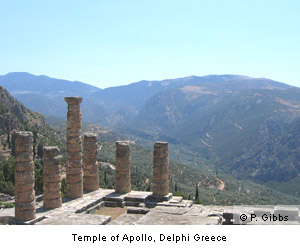
Pilgrimage in Early Christian Tradition

Life as pilgrimage in early Christian writers
Letter to Diognetus
[Christians] live each in his native land but as though they were not really at home there [as sojourners]. They share in all duties as citizens and suffer all hardships as strangers. Every foreign country is a fatherland to them, and every fatherland a foreign land ... They dwell on earth but they are citizens of heaven
Letter to Diognetus, 5
The concept of Christians as citizens of heaven and pilgrims, or 'temporary residents', travelling towards the heavenly homeland appears in the writings of many of the Fathers of the Church. Adam, Eve and their descendants are seen as involuntary exiles on earth suffering the results of human disobedience. However there is still hope. Those who so choose may become voluntary pilgrims, renouncing earthly security in order to journey towards heaven. Writers who explore these themes include Origen, Clement of Alexandria, Cyprian, St John Chrysostom, St Augustine, Caesarius of Arles and Gregory the Great. They emphasise the essential transience of worldly possessions and encourage Christians instead to look to the eternal security promised to those who invest in the values and rewards of the heavenly Jerusalem.

The concept of ultimately belonging elsewhere strengthened Christians in times of persecution. It also challenged them to obey God's commandments as they related to the world around them lived day by day. Following the New Testament, early Christian writers stress the importance of living as a prospective citizen of heaven, involved in human communities yet always aware of a higher allegiance and the need to live according to God's standards. Cyprian, bishop of Carthage (249-258), writes, 'We should reflect constantly that we have renounced the world and as strangers and foreigners we sojourn here for a time' (On Mortality, Ch 26).
One of the most influential writers on this topic was Augustine of Hippo (354-430). In his major work Concerning the City of God against the Pagans, written after Rome had been overrun and sacked by the Goths in 410, Augustine suggests that there are not one but two cities, one earthly, one heavenly. Their members live alongside one another in this world but hold different values, expectations and priorities (Book XVIII: 54). He therefore encourages Christians to see themselves as pilgrims travelling through the world, using its resources but not ensnared by them.
The desert and the growth of monasticism

Some Christians in the late third and early fourth century responded to the concept of being 'pilgrims and strangers' in the world in a particularly radical way. The ascetic movement which developed from the mid-third century onwards was in part a reaction to what was seen as an increasingly materialistic and sometimes hostile environment. Growing numbers retreated from cities such as Rome and Alexandria to seek spiritual solitude in the deserts of Judea, Syria and Sinai. St Paul of Thebes (d.c.340), is traditionally credited with being the first hermit. Another key figure was St Anthony who is described battling with demons that attacked him because of his holiness of life. Mary of Egypt is said to have been a converted prostitute who fled the sinfulness of her former life to find 'rest' in the wilderness.
These hermits (from eremos, desert) or anchorites (from anachorein, to withdraw) lived in small cells carved out of the rock, where they prayed and meditated on the Bible. They led a life of extreme asceticism, willingly suffering deprivation in this world in order to win 'citizenship in heaven' (Life of Anthony, 14). In time these Desert Fathers and Mothers attracted both disciples and visitors, keen to learn from and share in their holiness.

Not all were suited to the solitary life so coenobitic communities sprang up sharing a common rule of life. Descriptions of these early monks were transmitted to the Church in the West through the writings of John Cassian and many of their emphases were incorporated into western monasticism by St Benedict (d.c.547). Both forms of life, coenobitic and anchoritic, were understood as a permanent state of pilgrimage-exile in which individuals remained within the cell or cloister in order that their spirits might journey more freely. Concepts of exile, stability and inner journey thus lay at the very heart of the monastic movement.
Paul of Thebes, Anthony of Egypt, and others who followed them into the wilderness, embodied a way of spiritual journeying that would influence Christian thought and practice for centuries to come. The monastic movement became central to the mission of the Church, shaping its worship and sustaining its intellectual life. Figures such as Anthony, Paul and St Mary of Egypt were also the heroes and heroines of the solitary life, whose example inspired the Anglo-Saxon saints Cuthbert and Guthlac, and provided role models for the anchorites of the later Middle Ages.
Religious journeys in the Greek and Roman worlds

The Christian Church came into being within the Roman Empire alongside pagan Greek and Roman religious traditions that included journeys to sacred sites. Such sites were frequently characterised by striking geographical features. People often travelled long distances, sometimes as individuals, sometimes as part of a delegation from their city to sites associated with a particular god, such as Zeus, Apollo or Asklepios.
On arrival they would take part in a range of rituals:
- Pan-Hellenic Festivals, which drew participants from all over Greece, included musical, athletic and equestrian competitions held in honour of the god. The most famous was the festival in honour of Zeus at Olympia.
- Consultation of an oracle, such as that of Apollo at Delphi.
- Sleeping by the shrine of the god in search of healing.
- Giving ex voto offerings (such as representations of the part of the body believed to have been healed) in thanks for a cure or other benefit received.
- Viewing the image of the god and the votive offerings which demonstrated past cures.
These journeys took place over several centuries and practice varied during that period. There is considerable discussion among scholars today about whether these journeys can be described as pilgrimages in the same sense as those undertaken in Christian tradition. Nevertheless, these practices form an important part of the background against which Christian pilgrimage to sacred places developed in the fourth century CE.
Dee Dyas



